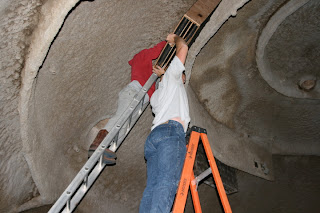It is generally assumed that most Mexican Free-tails (Tadarida braziliensis) head for Mexico and other countries south where the temperatures are warm and bugs are available during the cooler months between October and March. However, it is clear from the pictures I've taken of the bat boxes inside the Chiroptorium that many bats have stayed in the bat-boxes where the heat of their bodies accumulates and they stay warm. We think that in the warm spells they fly out in the evening and find some insects to eat.
In "Bats of Texas" by David J. Schmidly indicates that Cave Myotis (Myotis velifer) spend winters in caves, rock crevices, old buildings, culverts, and bat houses in central and north-central parts of Texas. The two inhabited bat boxes in the Chiroptorium have populations that consist of both species. In the photo below the 2 bats that are in sharp focus are Cave Myotis. Their fur is tan and their ears and fur around their nose and eyes is dark.
The photograph below was taken of the box in the large main dome on the 8th of Feburary. I sent it to several bat biologists, and the answers I got on which species can be identified in the photo is that both Mexican Free-tails and Cave Myotis are sharing this box. Another biologist thought that all of the bats looked like Free-tailed bats in this picture.
What else do we find in the Chiroptorium?
On the cave floor there are many bat skeletons. Here we have 2 skulls, a spinal column with ribs, and a hand-wing.
 Dermestid beetles live on the floor of caves with bat colonies. They are flesh eating and so are their larvae.
Dermestid beetles live on the floor of caves with bat colonies. They are flesh eating and so are their larvae.Dermestid beetle larvae exoskeletons are found on the floor around bones in winter. They possess projections which look "furry". They are meat-eaters, and keep the cave floor clean of the flesh of dead bats during warm months.
 Some scientists study guano (bat droppings). Justin is collecting guano to send to a professor who looks for insects, eggs, and tiny creatures.
Some scientists study guano (bat droppings). Justin is collecting guano to send to a professor who looks for insects, eggs, and tiny creatures.What can we do to increase warm habitat for bats in winter?
When Dr. Thomas Kunz from Boston University visited the Chiroptorium in early January he and the other bat biologists were amazed to see that there were lots of bats in the bat boxes. They suggested that if we have more bat boxes we could have more bats stay during the winter. So, Steven and Justin built 3 more bat boxes, to be hung on eye-hooks embedded in the gunite on the ceiling which were placed there in 1997 when the Chiroptorium was built. The builder and designer, Jim Smith, thought that we might want to add items in the future. We thank him for that, and for his thoughtful design, construction and additions.
To install them, Steven got the box up on the shorter ladder, Justin climbed up to the ceiling on one side and got it firmly hung, then moved the long ladder to the other side and hung that side to the hook.
 The large dome of the Chiroptorium now has 4 boxes around the second curtain and a box in the center.
The large dome of the Chiroptorium now has 4 boxes around the second curtain and a box in the center.We hope and expect that our population of females (along with a few males) will return to the Chiroptorium in March. I will continue writing about them as spring arrives and bats return. Let me know if you like hearing about bats.







No comments:
Post a Comment